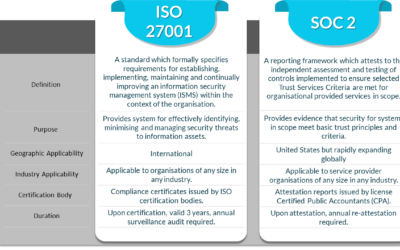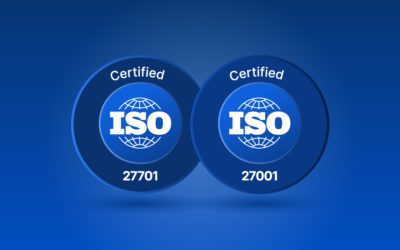In today’s rapidly evolving business landscape, organizations face mounting pressures to protect sensitive information, improve operational efficiency, and ensure customer satisfaction. To achieve these goals, businesses often seek internationally recognized standards that offer structured frameworks for continuous improvement. Two of the most widely adopted standards globally are ISO 27001 vs 9001. While both are part of the ISO (International Organization for Standardization) family, they focus on different areas of management. ISO 27001 vs 9001 is dedicated to information security management, whereas ISO 9001 is centered around quality management systems. Despite their differences, both standards share common principles, such as continuous improvement, risk management, and stakeholder satisfaction.
This article explores the key differences and similarities between ISO 27001 and ISO 9001, providing a comprehensive comparison that highlights their unique focus areas, benefits, and how organizations can leverage these standards to achieve strategic objectives.
What is ISO 27001 vs 9001?
ISO 27001 vs 9001 is an international standard that focuses on Information Security Management Systems (ISMS). The primary goal of ISO 27001 is to help organizations protect the confidentiality, integrity, and availability of information by implementing robust security controls. This standard provides a systematic approach to managing sensitive company data, ensuring that it remains secure from cyber threats, breaches, and unauthorized access.
ISO 27001 offers a risk-based approach to information security management, meaning that businesses must identify potential security risks, assess their impact, and implement appropriate controls to mitigate those risks. This process involves:
- Defining security objectives and scope.
- Conducting risk assessments.
- Implementing security controls (both technical and organizational).
- Regularly reviewing and improving the system.
Achieving ISO 27001 certification demonstrates that an organization has established an effective ISMS and adheres to globally recognized best practices for information security.
ISO 9001 is an international standard focused on Quality Management Systems (QMS). The primary aim of ISO 9001 is to ensure that organizations consistently deliver products and services that meet customer expectations and regulatory requirements. It is designed to help organizations improve their operational efficiency, enhance customer satisfaction, and foster a culture of continuous improvement.
ISO 9001 requires businesses to:
- Define their quality objectives.
- Establish processes and procedures that support quality management.
- Implement effective quality controls throughout the product or service lifecycle.
- Monitor, measure, and improve quality performance.
ISO 9001 certification signifies that an organization has implemented a robust quality management system that ensures consistent product quality and customer satisfaction.
Key Differences Between ISO 27001 and ISO 9001
While both ISO 27001 vs 9001 are essential for improving business operations, they have different focuses, scopes, and objectives. Below are the primary differences between the two standards:
1. Focus and Objective

The most significant difference between ISO 27001 and ISO 9001 is their core focus:
- ISO 27001 focuses on information security and the protection of sensitive data. It provides a framework for managing and securing information assets against threats such as cyberattacks, data breaches, and unauthorized access. Its primary objective is to ensure that an organization’s information remains confidential, accurate, and available to authorized parties only.
- ISO 9001, on the other hand, focuses on quality management. The aim is to ensure that organizations consistently deliver products or services that meet or exceed customer expectations, comply with regulatory requirements, and continuously improve operational efficiency.
While both standards emphasize risk management and continual improvement, their application and scope are very different. ISO 27001 deals specifically with managing risks related to information security, while ISO 9001 is concerned with managing the quality of products and services.
2. Scope and Applicability
- ISO 27001 applies specifically to the management of information security and is typically adopted by organizations that handle sensitive data, including customer information, intellectual property, financial data, or personal health information. This standard is applicable to all types of organizations, regardless of size or industry, but is particularly relevant to those in industries such as finance, healthcare, and IT, where the protection of data is critical.
- ISO 9001, by contrast, applies to the overall quality management system of an organization. It is applicable to any organization that wishes to enhance its operational processes and improve the quality of its products and services. This includes manufacturing, services, and even non-profit organizations. ISO 9001 is broader in scope than ISO 27001 and focuses on operational excellence across all business processes.
3. Risk Management Approach
- ISO 27001 adopts a risk-based approach to information security. It requires organizations to identify potential risks to their information and take appropriate measures to mitigate those risks. The standard emphasizes the need for businesses to assess and treat risks associated with data security, privacy, and confidentiality.
- ISO 9001, while also recognizing the importance of risk management, approaches it from a different perspective. The focus is on identifying and managing risks that affect the quality of products or services. This includes risks related to production, customer satisfaction, regulatory compliance, and the efficient use of resources. ISO 9001 encourages businesses to establish risk-based thinking in their decision-making processes to prevent potential issues that could affect product quality or customer satisfaction.
4. Documentation and Records
- ISO 27001 requires extensive documentation related to the ISMS. Organizations must document their information security policies, risk assessments, security controls, and incident response plans. Documentation is critical to ensuring that security practices are standardized and effectively implemented across the organization.
- ISO 9001 also requires documentation, but the focus is on quality control procedures, customer feedback mechanisms, and process improvements. Documentation in ISO 9001 ensures that quality management processes are defined, monitored, and consistently applied to achieve customer satisfaction.
5. Certification Process
Both ISO 27001 and ISO 9001 have a similar certification process, which involves:
- Initial assessments and gap analyses.
- Development of policies, procedures, and controls.
- Internal audits and corrective actions.
- External audits by a certification body.
However, the nature of the audits differs based on the area of focus:
- ISO 27001 audits primarily assess the effectiveness of an organization’s information security controls, risk management processes, and data protection practices.
- ISO 9001 audits assess the effectiveness of the organization’s quality management system, including product or service quality, customer satisfaction, and continuous improvement efforts.
While both certifications require similar steps, the specific documentation, controls, and processes are tailored to either information security or quality management.
6. Continuous Improvement
Both standards emphasize the principle of continual improvement, but they apply this concept in different contexts:
- ISO 27001 encourages continual improvement of the ISMS to address emerging threats, technological advancements, and changes in legal or regulatory requirements. The continual improvement process helps organizations enhance their information security posture over time and stay ahead of evolving security risks.
- ISO 9001 promotes continual improvement in all areas of quality management, ensuring that organizations consistently meet customer expectations and improve operational efficiency. The standard requires organizations to gather customer feedback, monitor performance, and make improvements based on data-driven insights.
Similarities Between ISO 27001 and ISO 9001
Despite their differences, ISO 27001 and ISO 9001 share several common features, which make them complementary to each other. Some of the similarities include:
1. Management System Approach

Both standards are based on the Plan-Do-Check-Act (PDCA) cycle, which encourages organizations to plan their processes, implement them, monitor their performance, and make improvements based on the findings. This management system approach helps organizations focus on continuous improvement and the efficient use of resources.
2. Risk Management
Both ISO 27001 and ISO 9001 emphasize the importance of risk management. While the specific risks they address are different (security risks vs. quality risks), both standards require organizations to identify, assess, and mitigate risks that could impact their business operations and objectives.
3. Customer Satisfaction
Customer satisfaction is a key focus for both standards. While ISO 9001 directly aims to improve customer satisfaction by ensuring high-quality products and services, ISO 27001 indirectly supports customer satisfaction by safeguarding their sensitive information and ensuring trust.
4. Documentation and Evidence-Based Decisions
Both standards require organizations to maintain thorough documentation of their processes, controls, and performance. This documentation serves as evidence that the organization is complying with the standard’s requirements and can be used to track progress and identify areas for improvement.
How to Implement ISO 27001 and ISO 9001 Together
Many organizations choose to implement both ISO 27001 and ISO 9001 simultaneously to address both information security and quality management needs. Implementing these standards together can provide significant benefits, including:
- Streamlined audits: Since both standards require similar steps in the certification process, organizations can conduct joint audits for both ISO 27001 and ISO 9001, saving time and resources.
- Synergy in risk management: By managing both quality and security risks together, organizations can develop a comprehensive risk management strategy that addresses both operational efficiency and data protection.
- Comprehensive improvement: Implementing both standards helps organizations improve both the quality of their products and services and the security of their information, leading to enhanced overall performance and customer satisfaction.
Conclusion
ISO 27001 and ISO 9001 are two critical standards that help organizations manage different aspects of their operations. While ISO 27001 focuses on information security and the protection of sensitive data, ISO 9001 is centered around quality management and customer satisfaction. Both standards share common principles, such as risk management, continuous improvement, and customer focus, making them complementary to each other.



0 Comments